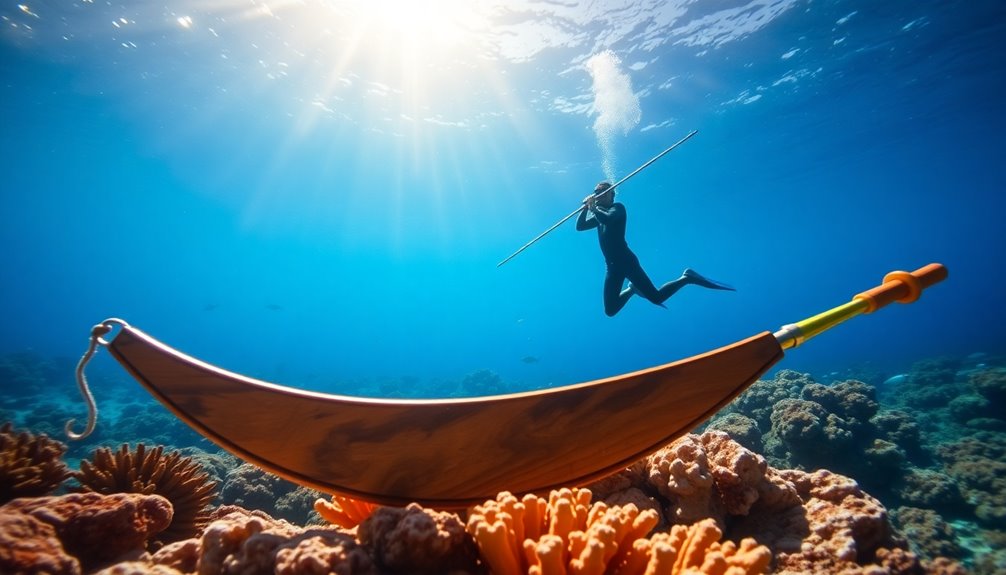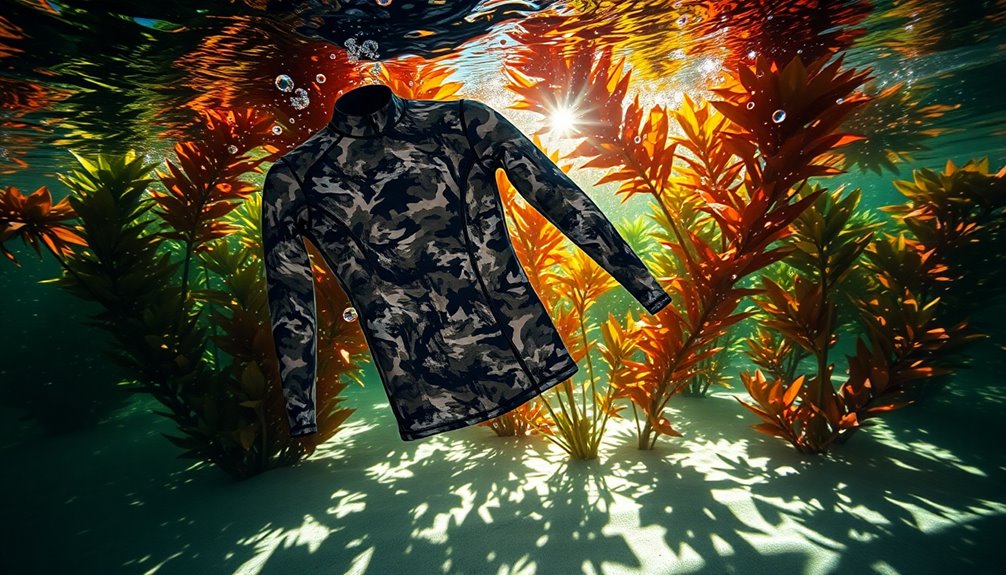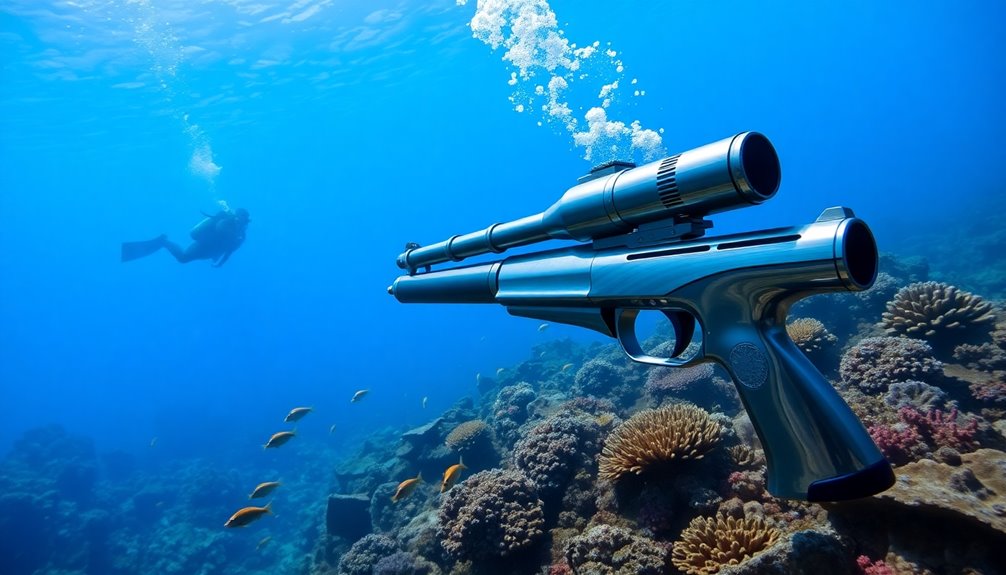A speargun can transform your casual swim into an exciting seafood feast! With it, you can explore vibrant underwater ecosystems while hunting for fish. All you need is a reliable spear, a quality wetsuit, and some knowledge of fish behavior. Plus, it's all about patience and stealth. Choose the right location, like reefs or rocky outcrops, and time your dive for the best results. Once you catch your fish, proper cleaning and cooking techniques will elevate your meal. There's plenty more to learn about maximizing your spearfishing experience and ensuring sustainable practices.
Key Takeaways
- Equip yourself with a reliable speargun and essential gear to maximize your chances of catching fish during casual swims.
- Select ideal locations like reefs or rocky outcrops, particularly during early mornings or late afternoons for optimal fish activity.
- Employ stealth techniques and understand fish behaviors to increase your likelihood of successful catches while underwater.
- Properly clean and prepare your catch using diverse cooking methods to transform your seafood into a delicious banquet.
- Engage with local conservation efforts to ensure sustainable practices while enjoying the benefits of your spearfishing experience.
What Is Spearfishing?
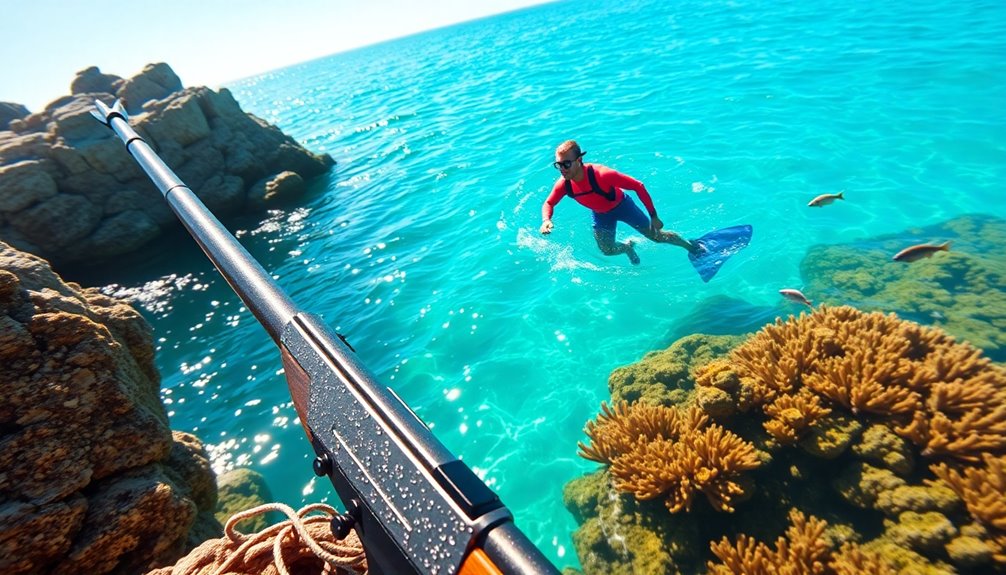
Spearfishing is an exciting underwater hunting method that lets you catch fish using a spear or speargun. This technique requires you to understand marine ecosystems and fish behavior, giving you a fighting chance against your underwater prey.
Unlike traditional fishing, spearfishing allows for more sustainable practices, as you can target specific species while minimizing bycatch.
You can enjoy this thrilling sport in various environments, from coastal waters and vibrant reefs to tranquil freshwater lakes. Each setting presents unique challenges, and you'll need to adapt your techniques and approach accordingly.
Success in spearfishing hinges on stealth and patience; blending into the underwater world is vital to avoid scaring off fish.
It's also important to remember that adhering to local regulations and conservation practices is fundamental. By doing so, you help guarantee the sustainability of fish populations and preserve marine habitats for future generations.
Fundamentally, spearfishing isn’t just about the catch; it’s about respecting the environment and enjoying the thrill of the hunt. The excitement comes from the challenge of stalking fish in their natural habitat and honing one’s skills in the water. To enhance this experience, it’s essential for divers to have the right gear, which includes specialized spearfishing equipment for every diver. This equipment not only boosts efficiency and effectiveness but also ensures a safe and enjoyable interaction with marine life.
Essential Gear for Spearfishing
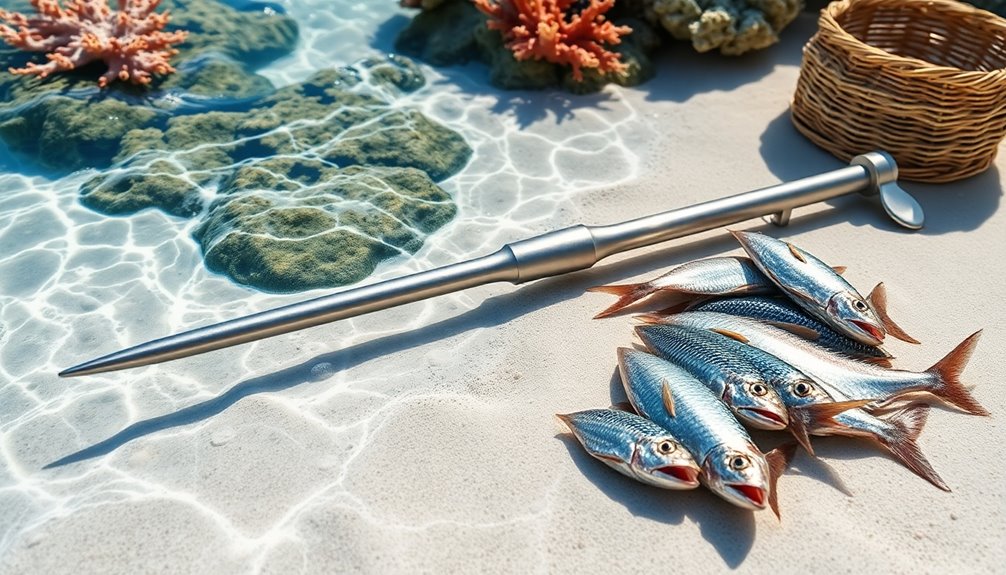
When diving into the world of spearfishing, having the right gear is essential for both safety and success. You'll need a reliable speargun, as it's your primary tool for catching fish.
A quality wetsuit not only provides warmth but also protects you from potential hazards underwater. Don't forget a comfortable mask and fins; they'll enhance your visibility and mobility, making your dives more effective.
Safety should be a top priority, so consider using a dive flag to signal your presence to boats. This guarantees you remain visible in the water.
Regular maintenance of your essential gear for spearfishing is key—check your wetsuit for leaks and verify your speargun is rigged properly for peak performance.
Weights can also improve your diving experience by helping you sink more easily and achieve better stability. This added stability allows for stealthier movements as you hunt.
If you're venturing into blue water, breakaway rigging becomes essential, allowing you to release the fish safely while minimizing the risk of losing your spear.
With the right gear, you're set for an exciting and successful spearfishing adventure!
Techniques for Successful Hunting
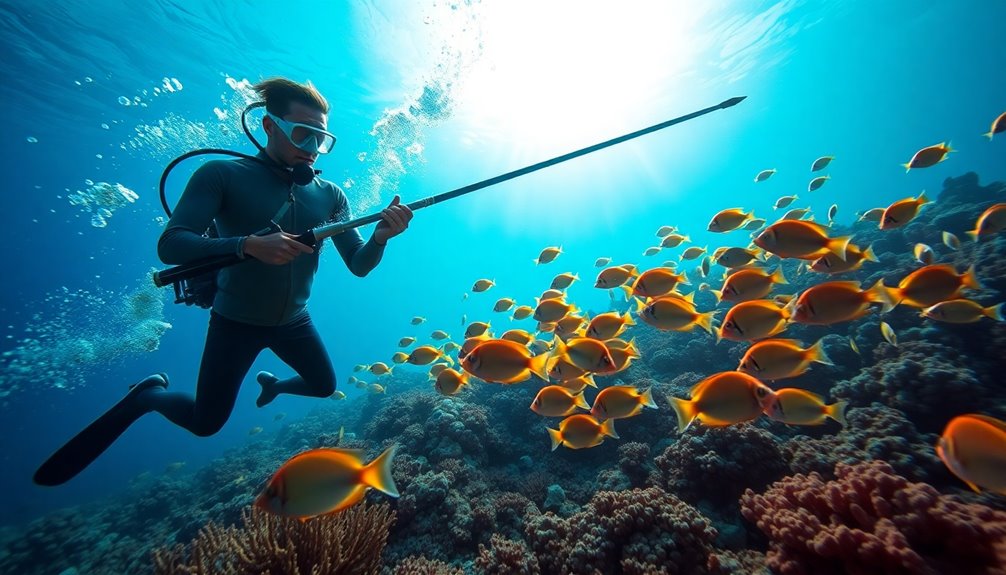
Successful hunting in spearfishing relies heavily on a few key techniques that can make all the difference in your experience. First, practice stealth and slow movements when approaching fish. Quick motions can scare them away, so take your time to get close enough for a successful shot. Next, understanding fish behavior and their feeding patterns can increase your chances of targeting specific species effectively.
Additionally, proper equalization techniques are essential, especially when diving deeper where pressure changes are more pronounced. Don't forget to practice breath-holding techniques; a little bit of extra time underwater allows you to hunt and observe marine life more effectively. Finally, identifying ideal spearfishing locations, like reefs and underwater structures, can greatly enhance your success rate.
| Technique | Description | Benefits |
|---|---|---|
| Stealth Movements | Move slowly and quietly to avoid scaring fish | Increases chances of a successful shot |
| Understanding Behavior | Learn feeding patterns and school habits | Targets specific species effectively |
| Equalization Techniques | Practice equalizing pressure during dives | Prevents injury in deeper waters |
| Ideal Locations | Focus on reefs and structures for diverse fish | Enhances overall success rate |
Safety Tips for Spearfishing

Diving into the underwater world can be thrilling, but safety should always come first. Before you initiate your spearfishing adventure, keep these essential safety tips for spearfishing in mind to guarantee a fun and secure experience.
- Always dive with a buddy. This not only enhances safety but also provides assistance in emergencies, greatly reducing risks while underwater hunting.
- Use a dive flag. Signal your presence to boats and other watercraft to prevent accidents and make sure you're visible while spearfishing.
- Be aware of your surroundings. Familiarize yourself with local marine life and potential hazards, like jellyfish or sharp coral, to avoid injuries during your dives.
Additionally, practice proper equalization techniques to prevent barotrauma and guarantee a safe ascent and descent.
Before you dive, conduct a pre-dive safety check of your gear, including your speargun and buoyancy control devices, to confirm everything is functioning correctly.
Cooking Your Catch

Once you've caught your fish, cleaning it properly is essential for the best flavor and safety.
You'll want to season it well, using herbs and spices that enhance its natural taste.
Then, choose a cooking method like grilling or pan-frying to achieve that perfect crispy exterior while keeping it tender inside.
Preparing Your Fresh Catch
After landing your fresh catch, it's important to clean it properly to preserve its flavor and freshness. Start by removing the scales, guts, and gills. This step is vital for guaranteeing your fish tastes as good as possible.
Once cleaned, you can focus on preparing your fresh catch for cooking.
Here's a quick checklist to help you through the process:
- Rinse thoroughly: Remove any remaining blood or slime for a cleaner taste.
- Pat dry: Use paper towels to absorb excess moisture, which helps achieve a crispy texture when cooking.
- Store properly: If you're not cooking immediately, keep your fish on ice or in the refrigerator to maintain its quality.
When you're ready to cook, consider grilling or pan-searing over a hot plate with butter for that perfect crunch. Additionally, using a powerful filter pump can help maintain a clean cooking environment if you're preparing your meal outdoors.
Remember, presentation matters! Arrange your beautifully cooked fish alongside fresh sides, like a Caesar salad, to create a balanced and delicious meal.
Seasoning for Flavor Boost
To enhance the natural flavors of your freshly caught fish, you'll want to season it thoughtfully before cooking. For fish like Mangrove Jack, seasoning for flavor boost is vital. A simple blend of lemon herb and garlic can elevate the taste, allowing the seafood's freshness to shine through.
Make certain to clean the fish immediately after your catch; this step guarantees peak freshness and quality, which are essential for achieving the best flavor.
When you're ready to cook, consider using a hot plate with butter. This not only introduces a rich flavor but also creates that delightful sizzling sound, signaling that your fish is cooking perfectly.
Pair your seasoned fish with a Caesar salad for a complementary balance of flavors that enhances your meal experience.
Don't forget about presentation! Arranging your fish and salad attractively can greatly elevate the appeal of your seafood banquet.
A well-seasoned and beautifully presented dish makes for a memorable dining experience, transforming your casual swim into a feast. Enjoy the fruits of your labor and savor every bite!
Cooking Techniques Explained
Cooking your catch involves a few key techniques that can elevate the flavor and texture of your fish. First, make sure you clean your fish thoroughly by removing the scales and entrails. This step is essential for freshness and enhances the flavor before cooking.
Next, season your fish with ingredients like lemon herb and garlic to complement its natural taste.
Here are some cooking techniques explained to maximize your seafood experience:
- Grilling: Cooking your fish on a hot plate locks in moisture and provides a satisfying texture.
- Pairing: Serve your fish with a fresh salad, such as a Caesar salad, for a crunchy contrast that balances the meal's richness. Incorporating fermented vegetables can also add a tangy flavor that complements the fish beautifully.
- Presentation: Arrange your cooked fish and salad appealingly to impress your guests and elevate the dining experience.
Using these techniques won't only enhance the flavor of your catch but also make your meal visually appealing.
Community and Conservation

Engaging in community conservation efforts not only protects essential marine ecosystems but also enhances your experience as a spearfisher. By participating in initiatives like beach clean-ups and habitat restoration, you contribute to the health of the waters you love to explore. This sense of responsibility fosters camaraderie among spearfishers who share knowledge and advocate for sustainable practices. Additionally, understanding the importance of responsible fishing practices can help maintain the delicate balance of marine biodiversity.
| Conservation Efforts | Benefits |
|---|---|
| Beach Clean-Ups | Reduces pollution, protects marine life |
| Habitat Restoration | Enhances fish populations and biodiversity |
| Responsible Fishing Practices | Guarantees species sustainability |
| Collaboration with Marine Organizations | Strengthens regulations and awareness |
When you engage with local conservation projects, you strengthen the community's commitment to respecting marine biodiversity. This education encourages you to be mindful of the species you target, ultimately contributing to the overall health of the ocean. Together, you and your fellow spearfishers can guarantee that future generations enjoy the same thriving marine environments, making your adventures not just about catching fish, but also about preserving the beauty of the underwater world.
Choosing the Right Location
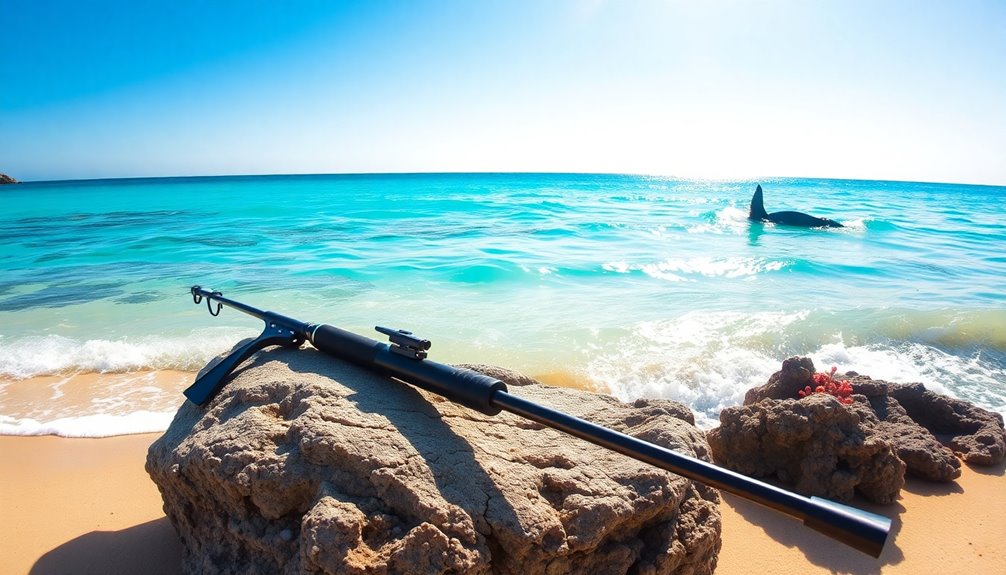
Where should you start your spearfishing adventure? Choosing the right location is essential for a successful catch. Ideal spots to explore include reefs, rocky outcrops, and underwater structures. These areas provide shelter for fish, making them hotspots for spearfishing.
Consider these factors when selecting your location:
- Time of Day: Early mornings and late afternoons are typically the most productive times for spearing.
- Underwater Currents: Learning to read currents can greatly boost your success, as fish often gather where currents converge.
- Vegetation: In freshwater environments, target fish around beds of vegetation at depths of 10-25 feet, where food and shelter abound.
Frequently Asked Questions
Why Is Spearfishing With Scuba Illegal?
Spearfishing with scuba gear is illegal in many regions because it can lead to overfishing and disrupt marine ecosystems.
When you use scuba, you dive deeper and catch more fish than you could while free diving, which harms fish populations.
Plus, the longer dive times increase safety risks, like decompression sickness.
Regulations aim to promote sustainable practices and guarantee a balanced environment, so you should always check local laws before spearfishing.
Do You Need a Permit to Spearfish?
You might think you can just plunge in and start spearfishing without any hassle, but that's often not the case.
In many areas, you'll need a permit to spearfish legally. It's essential to check your local regulations, as they can vary widely.
Some places have specific restrictions on species or even designated zones where spearfishing is prohibited.
Always carry your permits with you while diving to avoid any legal issues.
What Are the Three Types of Spear Fishing?
The three types of spearfishing you can explore are freediving, scuba spearfishing, and blue water spearfishing.
Freediving lets you hunt while holding your breath, making it a thrilling challenge.
If you prefer diving deeper and longer, you might choose scuba spearfishing, though it requires certification.
For targeting larger fish in open waters, blue water spearfishing involves attracting fish with chumming and using specialized gear.
Each type has its own techniques and regulations to follow.
How Risky Is Spearfishing?
Spearfishing can feel like diving into a thrilling underwater adventure, but it's not without its risks.
You've got to be aware of dangerous marine life and local hazards lurking nearby. Using a buddy system is essential for safety, ensuring you've got help if things go south.
Mastering equalization techniques is vital to avoid serious injuries, and you should always carry safety gear to signal your presence and navigate safely through the waters.
Conclusion
As you dive beneath the waves, think of yourself as a modern-day Poseidon, wielding not a trident but your trusty spear gun. Each fish you encounter is a treasure waiting to be discovered, contributing to a feast that connects you to the ocean’s bounty. Remember, it’s not just about the catch; it’s about respecting the sea and nurturing its life. So, gear up, explore, and turn your casual swim into a glorious banquet that honors both your skill and the ocean’s gifts. As you navigate deeper into this underwater paradise, ensure you have your lobster diving essentials for beginners at hand, like a sturdy pair of gloves and a reliable gauge. Every dive offers a unique chance to learn and appreciate the delicate ecosystems that thrive beneath the surface. As you emerge from the water, brimming with your harvest, take a moment to reflect on the balance between the thrill of the hunt and the importance of conservation, ensuring that future generations can enjoy these incredible underwater experiences as well.


